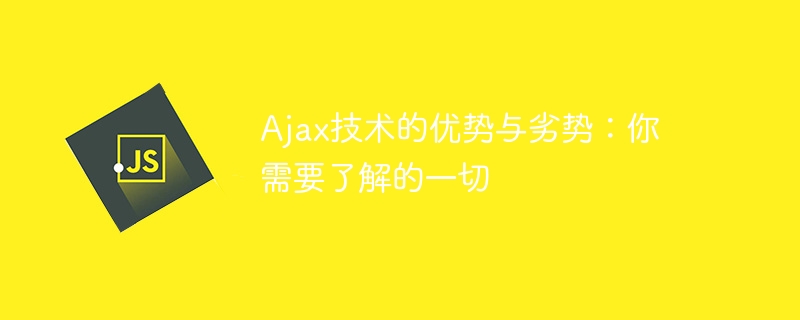
Advantages and Disadvantages of Ajax Technology: Everything You Need to Know, Need Specific Code Examples
Introduction:
With the development of Web applications, users have The demand for more efficient, faster, and friendlier interactive experiences is also growing. The emergence of Ajax (Asynchronous JavaScript and XML) technology has greatly promoted the development of Web applications. Ajax provides users with a smoother interactive experience by using JavaScript and XML to implement asynchronous communication with the server. This article will introduce the advantages and disadvantages of Ajax technology and give specific code examples.
1. Advantages:
- Improve user experience:
Ajax technology realizes the function of obtaining data without refreshing the entire page through asynchronous communication. This greatly improves the user experience, allowing users to operate web pages more smoothly without waiting for page refreshes. For example, in the message board page of the website, users can view new messages in real time through Ajax without refreshing the entire page.
- Reduce server load:
Ajax reduces the load on the server by partially refreshing the page and only obtaining the required data. Compared with traditional synchronous requests, Ajax can reduce the use of network bandwidth and reduce the pressure on the server through partial updates.
- Improve page efficiency:
Ajax technology can divide page functions into different modules, and each module can use Ajax to obtain data asynchronously. In this way, the page loading speed is greatly improved. For example, in a product list page, Ajax can be used to asynchronously obtain the detailed information of each product, thus improving the efficiency of the page.
- Support multiple data formats:
Ajax technology not only supports data in XML format, but also supports the transmission and parsing of multiple data formats such as JSON, HTML, and Text. This allows us to be more flexible in handling different types of data, thus providing a better user experience.
Code example:
The following is a simple Ajax example that asynchronously obtains background data and updates part of the page.
<script>
function getData() {
var xhttp = new XMLHttpRequest();
xhttp.onreadystatechange = function() {
if (this.readyState == 4 && this.status == 200) {
document.getElementById("demo").innerHTML = this.responseText;
}
};
xhttp.open("GET", "data.php", true);
xhttp.send();
}
</script>
<body>
<button onclick="getData()">点击获取数据</button>
<div id="demo"></div>
</body>Copy after login
2. Disadvantages:
- Security issues:
Ajax requests are initiated through JavaScript code, which means that users can directly view the URL and parameters of the ajax request , which may cause security issues. In order to solve this problem, we need to authenticate and authorize the request in the background, and use the HTTPS protocol to ensure the secure transmission of data.
- Unfriendly to search engines:
Since Ajax technology obtains data asynchronously through JavaScript code, and search engine crawlers do not execute JavaScript code, they cannot obtain content loaded through Ajax. This means that if a website relies primarily on content loaded via Ajax, search engines will not be able to access this content, which may have an impact on the website's SEO.
- Communication error handling is more complicated:
Because Ajax initiates an asynchronous request through JavaScript code, network abnormalities and other problems may occur during the request process. Handling these errors requires additional code for error handling, making the code more complex.
Conclusion:
Ajax technology brings many advantages through asynchronous communication, such as improving user experience, reducing server load, improving page efficiency, etc. However, there are also some disadvantages, such as security issues, unfriendliness to search engines, and complicated error handling. When using Ajax technology, we need to weigh its advantages and disadvantages and choose whether to use it according to the specific application scenario.
References:
- https://www.w3schools.com/xml/ajax_intro.asp
- https://www.javatpoint.com/jquery -ajax-tutorial
Note: The above code example is a simplified version and is only used to demonstrate the basic usage of Ajax technology and does not include complete error handling and security measures. In actual application, it needs to be improved according to specific circumstances.
The above is the detailed content of Understanding the Pros and Cons of Ajax Technology: A Comprehensive Introduction. For more information, please follow other related articles on the PHP Chinese website!






